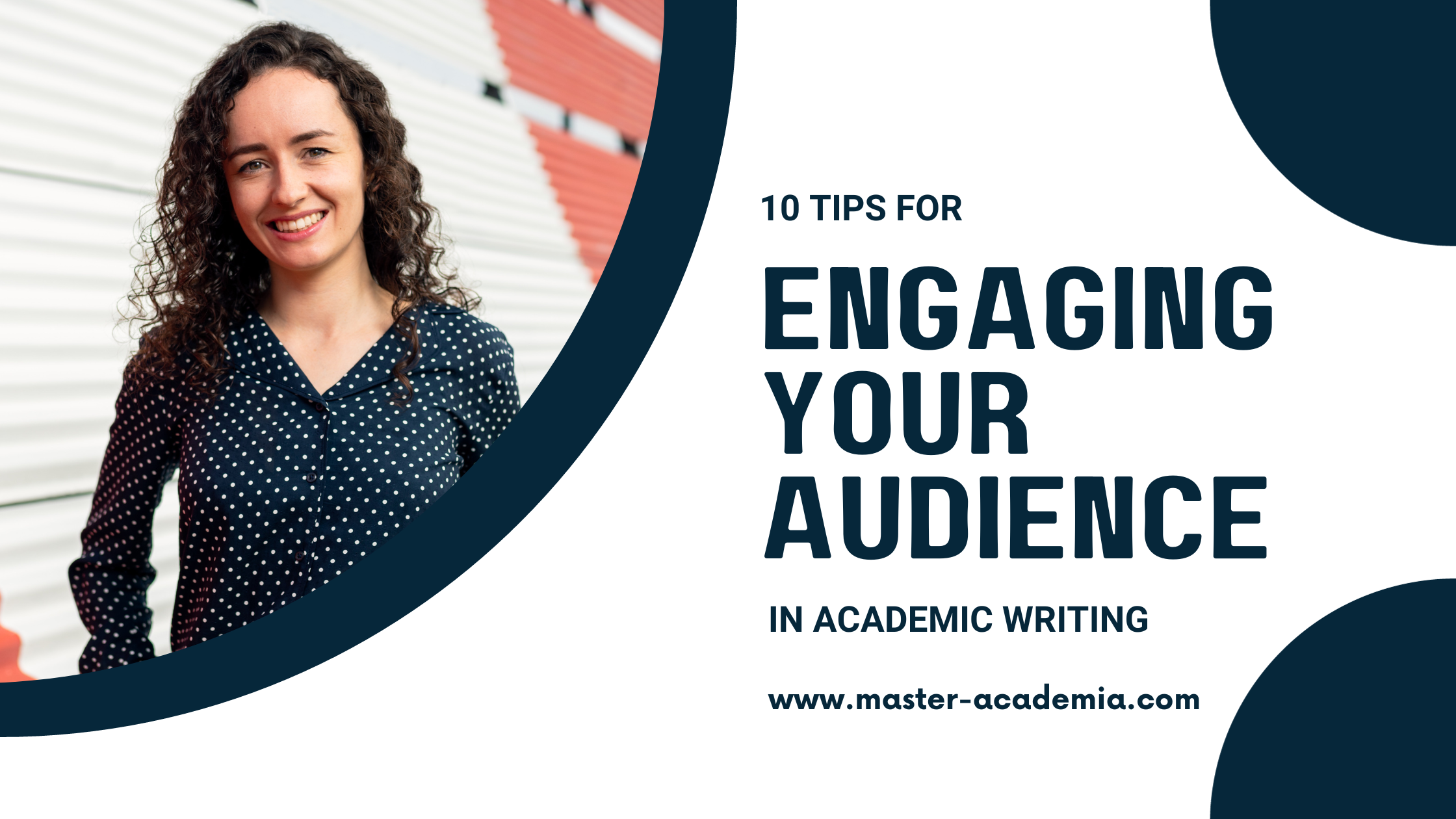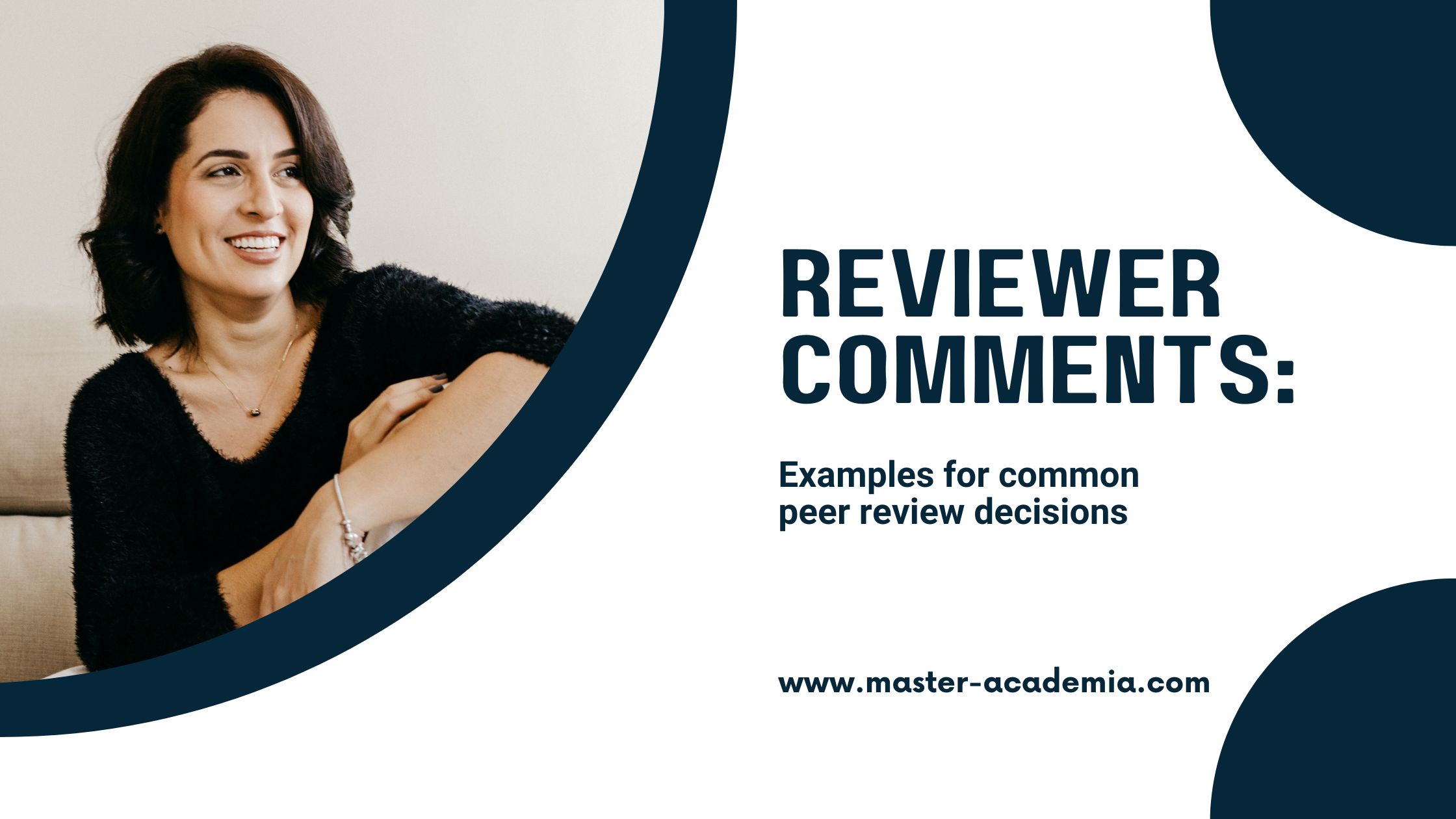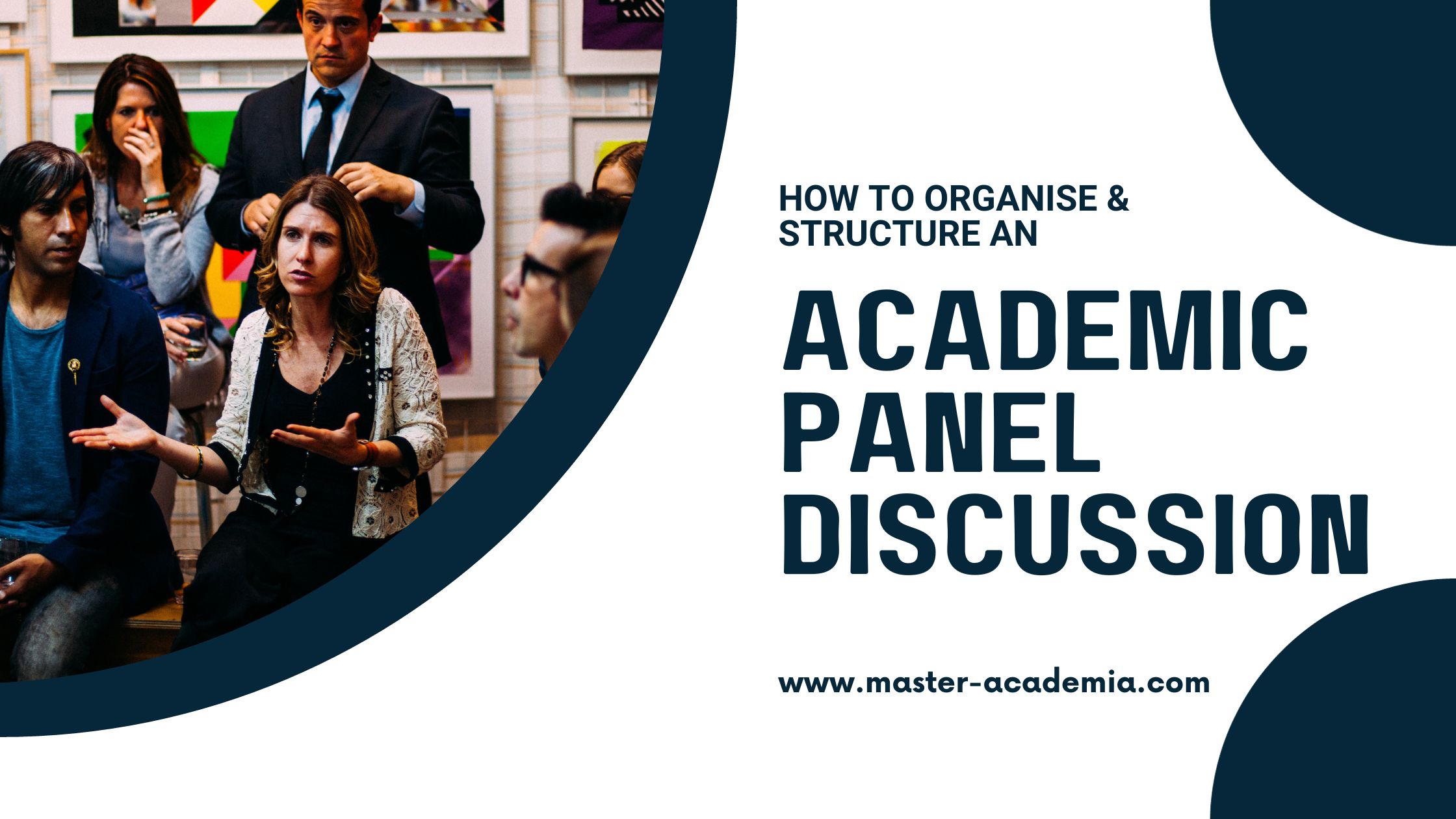
Panel discussions often appear intimidating, as high-profile events featuring expert discussions at academic conferences. But what precisely are panel discussions, what different types exist, and how can you embark on organizing one yourself? Here is your ultimate guide to understanding, organizing and structuring academic panel discussions, including four example structures and a step-by-step plan to help you get started.
Contents
What constitutes a panel discussion at an academic conference?
A panel discussion brings together a number of individuals who share insights and perspectives on a specific subject matter.
In the context of academic conferences, panel discussions invariably revolve around research topics, amalgamating diverse viewpoints from academics immersed in the field.
The spectrum of panel discussions is remarkably broad. Some may focus on a very specific processes or phenomena, while others may cast a wider net, deliberating the future of an entire academic discipline or exploring wider trends like the use of AI in research.
How many people participate in an academic panel discussion?
In terms of panel size, there is no one-size-fits-all approach; it varies from one conference to the next. Nevertheless, a typical panel generally comprises 3 to 6 panelists, in addition to the moderator. It’s customary for the panel organizers to take on the role of panel moderators, guiding the discourse and ensuring its smooth progression.
How long does an academic panel discussion typically last?
Furthermore, panel discussions can exhibit considerable variation in their duration, yet more often than not, they fall within the range of 60 to 120 minutes.
Are panel discussions the same thing as roundtable discussions?
Panel discussions and roundtable discussions bear many similarities, and conference organizers occasionally use these terms interchangeably. In strict terms, however, there exists a subtle distinction, with roundtable discussions leaning towards informality and a reduced level of structure compared to panel discussions. Nevertheless, given the potential ambiguity surrounding these terms, it is advisable to reach out to the specific conference organizers to gain a clear understanding of their expectations and the exact nature of either format.
Understanding different types of academic panel discussions
There is a multitude of panel discussion types, and academic conferences frequently specify particular requirements in their call for panel proposals. Some of the most common types include:
- Traditional academic panel discussion: This format involves several participants who initially present their individual positions or research insights related to a particular topic. This typically includes one or two rounds in which they respond to specific questions or clarify their viewpoints. Subsequently, an unstructured, free-flowing discussion among panelists takes place. Towards the end, the panel often welcomes questions from the audience.
- Debate panel: In contrast to a more traditional panel discussion, a debate panel is designed to explore opposing views on a specific topic. Experts in the field clearly articulate and argue different standpoints, fostering a deeper examination of the subject. This type of panel discussion can be more adversarial, focusing on highlighting differences in opinions rather than similarities.
- Roundtable discussion: Roundtable discussions are types of panels at academic conferences that often feature panelists seated in a circle, with or without an actual round table. This informal setup is intended to promote a relaxed and casual exchange of ideas. Among the common panel discussion types at academic conferences, the roundtable discussion is the least structured, with a more organic and open discussion. In contrast, other types may involve more structured presentations, sometimes with the use of PowerPoint slides, before the interactive exchange occurs.
- Case Study Panel: This panel brings together scholars who conduct research on a specific topic or concept, often presenting case studies from various contexts. By merging these diverse case studies, a deeper understanding of the subject matter can be achieved, offering valuable insights to the audience.
These diverse panel discussion formats cater to different objectives, levels of formality, and audience engagement. Therefore, the initial step should always involve exploring the panel types that a conference permits or prefers. Subsequently, when free to choose, opt for the format that aligns most closely with your specific goals and the subject matter under consideration.
How to become a panel organizer at an academic conference
The most prevalent route to becoming a panel organizer is by responding to the call for panel or roundtable discussions, a process typically advertised on the conference website. Conference websites may offer different submission methods, with some utilizing online systems, while others may require you to complete a form or send an email to a designated address.
The application for organizing a panel closely resembles submitting an abstract to an academic conference. It typically entails providing a concise summary or description of the panel’s topic. Additionally, many conferences expect you to identify the prospective panelists, necessitating timely preparation.
It’s worth noting that deadlines for panel or roundtable discussion applications often precede the standard conference abstract submission deadlines.
Thus, early preparation is crucial, and it’s advisable to vigilantly monitor the conference website and stay updated on any announcements related to your chosen event.
Can early career researchers organize a panel at an academic conference?
Early career researchers can certainly organize a panel at an academic conference, and it offers numerous benefits. It’s a great way to gain valuable insights, expand your network by inviting more senior academics as panelists, and enhance your leadership skills for your academic CV. So, there’s no need to feel intimidated. Trying never hurts. If early career researchers believe they might face challenges in acceptance, highlighting their early career status and the fresh perspectives a new generation of researchers can bring is often appealing to conference organizers. Many conferences actively seek ways to support and promote early career scholars.
How to structure an academic panel discussion
There are numerous ways to structure an academic panel discussion, so it’s essential to carefully consider what makes the most sense for your topic and objectives. Regardless of the ultimate decision, developing a clear structure is crucial.
A well-structured panel discussion not only facilitates effective time management and moderation but also ensures a meaningful exchange of ideas.
A key element of a successful academic panel discussion structure is to include a clear introduction, along with reserving at least five minutes at the end to wrap up and summarize the discussion, leaving the audience with key takeaways from the session.
Here are a couple of practical examples of how this structure can be implemented.
Example structure of an academic panel discussion 1
In this scenario, a 1.5-hour panel discussion featuring three panelists is outlined. The session commences with an introduction that provides an overview of the panel’s central theme and introduces the panelists, offering a brief insight into their expertise and contributions. Following this, each of the three panelists is allocated 15 minutes to deliver their presentations. This is succeeded by a moderated discussion, where the panel moderator actively engages with the panelists, encouraging the exchange of ideas and responses to each other’s presentations. After a substantial discussion, the audience is invited to pose questions and participate in the ongoing conversation.
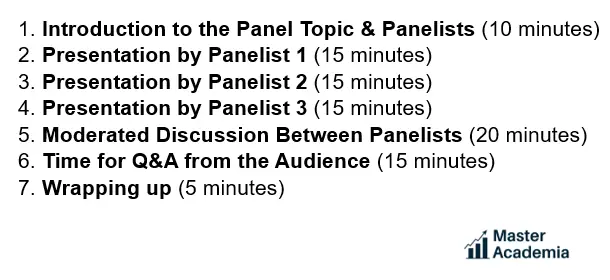
Example structure of an academic panel discussion 2
In the second scenario, we also have a 1.5-hour panel discussion. It commences with a concise introduction to the topic and an introduction of the participating panelists. The structure unfolds as follows: initially, the two panelists in favor of a specific statement present their opinions on the matter. Subsequently, there is a 5-minute interval dedicated to the panelists with opposing arguments to provide their rebuttals.
Following this, the panelists who hold opposing viewpoints share their perspectives, followed by a rebuttal from those panelists who are in favor of the statement. Just like the previous rebuttal, time is also allocated for the exchange of counterarguments and responses to the opinions opposing the statement.
The panel discussion then transitions into a moderated discussion, allowing for further exploration of the topic and fostering dialogue among the panelists. A segment for audience questions and answers is integrated, enabling active engagement from those attending the discussion. Finally, the session concludes with a wrap-up, summarizing the key points and takeaways from the discussion.
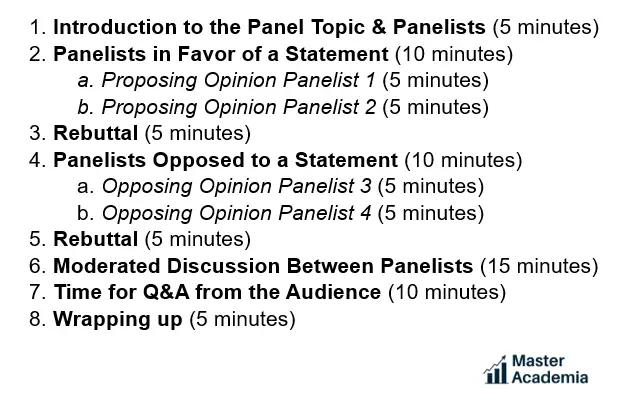
Example structure of an academic panel discussion 3
In the third scenario, a more informal roundtable format is adopted. In this setting, panelists do not delve into lengthy research insights but instead deliver concise key statements in response to two pre-defined questions. These questions are established by the panel organizers and are clearly introduced at the outset.
The session unfolds through two rounds of these succinct statements, enabling the audience to gain a clear understanding of the positions and viewpoints of the various panelists. Following this, the moderated discussion commences, fostering an in-depth exploration of the topic and encouraging interactive dialogue among the panelists. Adequate time is also reserved for the audience to actively contribute to the discussion by posing questions and sharing their perspectives.
The session concludes with a dedicated 5-minute wrap-up, summarizing the key takeaways and insights gleaned from the discussion, ensuring that the audience departs with a clear understanding of the discussion’s outcomes.
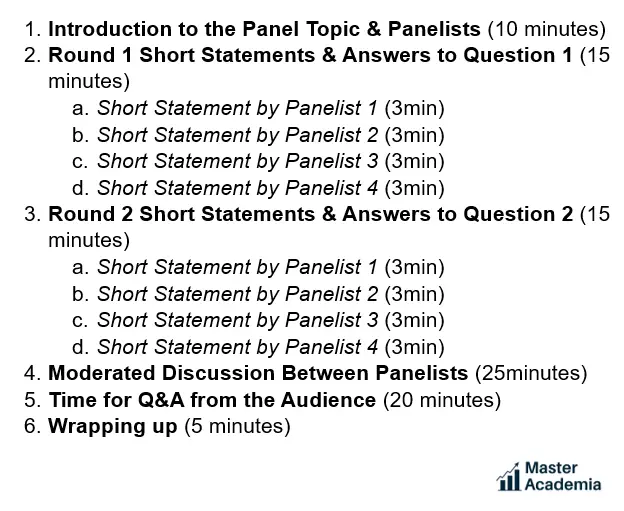
Example structure of an academic panel discussion 4
In the final scenario, we have a specialized case study panel. As the name implies, and after introducing the panel topic, invited panelists share their individual case studies based on their research. This 60-minute session is structured with three 10-minute presentations by the panelists, each offering a unique perspective on the topic.
The moderator plays a pivotal role in facilitating discussion among the panelists, encouraging them to draw out distinctions and commonalities between the presented case studies. This dynamic interaction adds depth and richness to the session by highlighting the nuances and connections within the field of study.
Furthermore, this scenario allocates time for audience participation, providing an opportunity for attendees to contribute questions and insights. The session concludes with final conclusions, summarizing the key findings and insights derived from the case studies, thus ensuring a comprehensive and informative closure to the discussion.
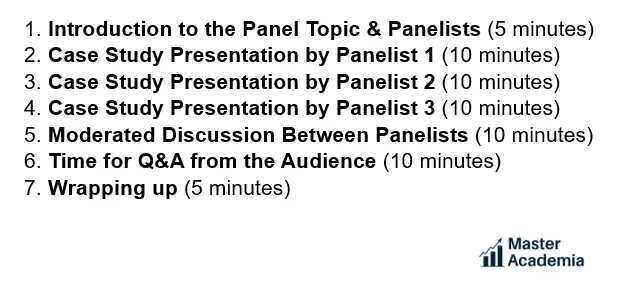
Step-by-step plan to organizing a panel discussion at an academic conference
This post includes a lot information but no worries: With a straightforward, step-by-step plan, you’ll gain a clear overview of the tasks at hand.
- Step 1: Begin by seeking out a call for panel session applications related to an academic conference. Alternatively, reach out to the conference organizers well in advance (ideally, at least 9 months before the conference date) to explore the feasibility of organizing a panel.
- Step 2: Familiarize yourself with the panel requirements, including considerations such as duration, the number of participants, and other relevant criteria.
- Step 3: Develop a compelling idea for your panel or topic and draft a concise preliminary summary.
- Step 4: Contact potential panelists, and express your interest in their participation. If they are happy to participate, make sure that they confirm their participation (as panelist participation typically requires attendance at the conference), and ask them to provide a brief summary of their intended contribution.
- Step 5: Refine your panel discussion application based on the confirmed panelists and ensure its timely submission well before the application deadline.
- Step 6: Upon receiving confirmation of your proposal’s acceptance, work on the concrete structure of your panel discussion. Share this structure with your panelists, including specific instructions on aspects like the use of PowerPoint presentations and speaking duration. You can also request that panelists submit their presentations or speaking points several weeks before the conference, allowing you ample time for moderation preparation.
- Step 7: Prepare for moderation by crafting an engaging introduction to the panel topic, emphasizing its relevance. Additionally, based on the panelists’ presentations or speaking points, develop a series of thoughtful questions or insights. These can be used to guide the discussion among panelists, enabling a more in-depth exploration of the topic.
- Step 8: Approximately four to two weeks before the conference, check in with your panelists to address any questions or concerns they may have. Once everything is in order, you’re all set and ready to go!

